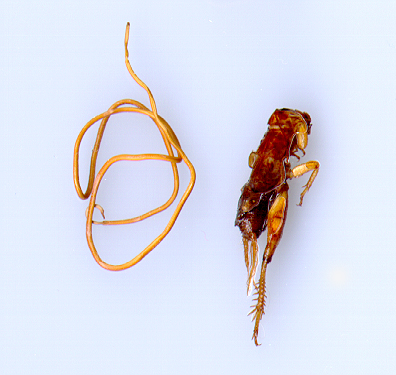Horsehair worms are parasites of certain insects, especially crickets and grasshoppers. They are commonly found in puddles of water, on damp sidewalks and patios, or as they emerge from bodies of their insect hosts. Despite their sometime frightening appearance, these creatures are not harmful and have no economic importance.
The long, thin structure of these worms is so similar to that of a hair that it was formerly thought that they were transformed from the tail hair of horses. Horse hairs frequently drop into watering troughs where they can accumulate. Coincidentially, insects (including those parasitized by horsehair worms) also frequently fall into the water of horse troughs and die. Horsehair worms which emerge from parasitized insects were seen swimming in water troughs and supposed to have spontaneously transformed from the long horse hairs; hence the term “horsehair worm”.
Biology
Horsehair worms are insect parasites that belong to the phylum Nematomorpha. One of the most common species in the United States in Gordius robustus.
The body of the horsehair worms is extremely long and thread-like. Lengths of a foot or more are not common. The body diameter is about the width of a pencil lead. They are creamy to blackish in color, and frequently are twisted and coiled like a discared thread.
Not much is known about the life of horsehair worms. Adults, the stage most commonly seen, live in water or very moist soil. Adults live in all types of fresh-water habitats and can be found in both temperate and tropical regions. They commonly swim or crawl about with a whip-like motion. Immature stages are parasites on insects or crustaceans living in or near water, or in moist soil. One species of horsehair worm lives in salt water and parasitizes crabs. Beetles, cockroaches, crickets or grasshoppers are the most common hosts in urban areas. Emergence from the host occurs only when the host is near water. Occasionally, horsehair worms are found after a cricket or cockroach is crushed, or when the host hops into a container of water, and the worm exits out of the insect’s body.
Importance
Since horsehair worms are parasitic, they are assumed to be beneficial in the control of certain insects. Its true value as a parasite, however, is questionable because the worm does not kill its host until it matures. Horsehair worms are not parasites of humans or pets. Therefore, these creatures are primarily of interest as one of nature’s oddities. If their presence in a swimming pool is bothersome, they can be safely removed by hand or with a net.
Horsehair worms can be confused with other parasitic worms of the phylum Nematoda. Parasitic nematodes are usually microscopic and can further be distinguished by the structure of the posterior (tail) of the body. The tail of parasitic nematodes is hooked and the anal opening occurs before the body’s end. In contrast, the end of Gordius horsehair worms have a cleft.
For more information
For more information about crickets and cricket control, see the fact sheet Cricket Control in the Fall. Information in this F@ctsheet was based, in part, on Pennak, R.W. 1978. Chapter 10: Nematomorpha (Horsehair worms, Gordian worms) pp. 231-238. in Freshwater Invertebrates of the United States. 2nd Ed. John Wiley and Sons, New York. 803 pp.
Authors
Michael Merchant, Ph.D., Professor and Extension Urban Entomologist, Texas AgriLife Extension Service
Mary Wicksten, Professor of Biology, Texas A&M University
